FY021 Business Report: HR Management, Motivation, and Finance
VerifiedAdded on 2023/04/26
|11
|2746
|316
Report
AI Summary
This report, part of FY021 Introduction to Business coursework, delves into key aspects of business management. It begins with an analysis of the role of Human Resources (HR) in hospitality organizations, focusing on HR's impact on organizational culture at the Conrad Hotel. The report explores motivational theories, including Maslow's hierarchy of needs and Hertzberg's two-factor theory, along with practical material incentives. The second part of the report focuses on financial management and reporting, covering financial management systems, the importance of financial reporting, and the objectives of financial management. It also examines the financial reporting system and the roles of various stakeholders. The report uses case studies and practical examples to illustrate the concepts, providing a comprehensive overview of HR, motivation, and finance within a business context. Students can access this report and other resources on Desklib to aid their studies.

FY021
INTRODUCTION TO
BUSINESS
COURSEWORK 2
INTRODUCTION TO
BUSINESS
COURSEWORK 2
Paraphrase This Document
Need a fresh take? Get an instant paraphrase of this document with our AI Paraphraser
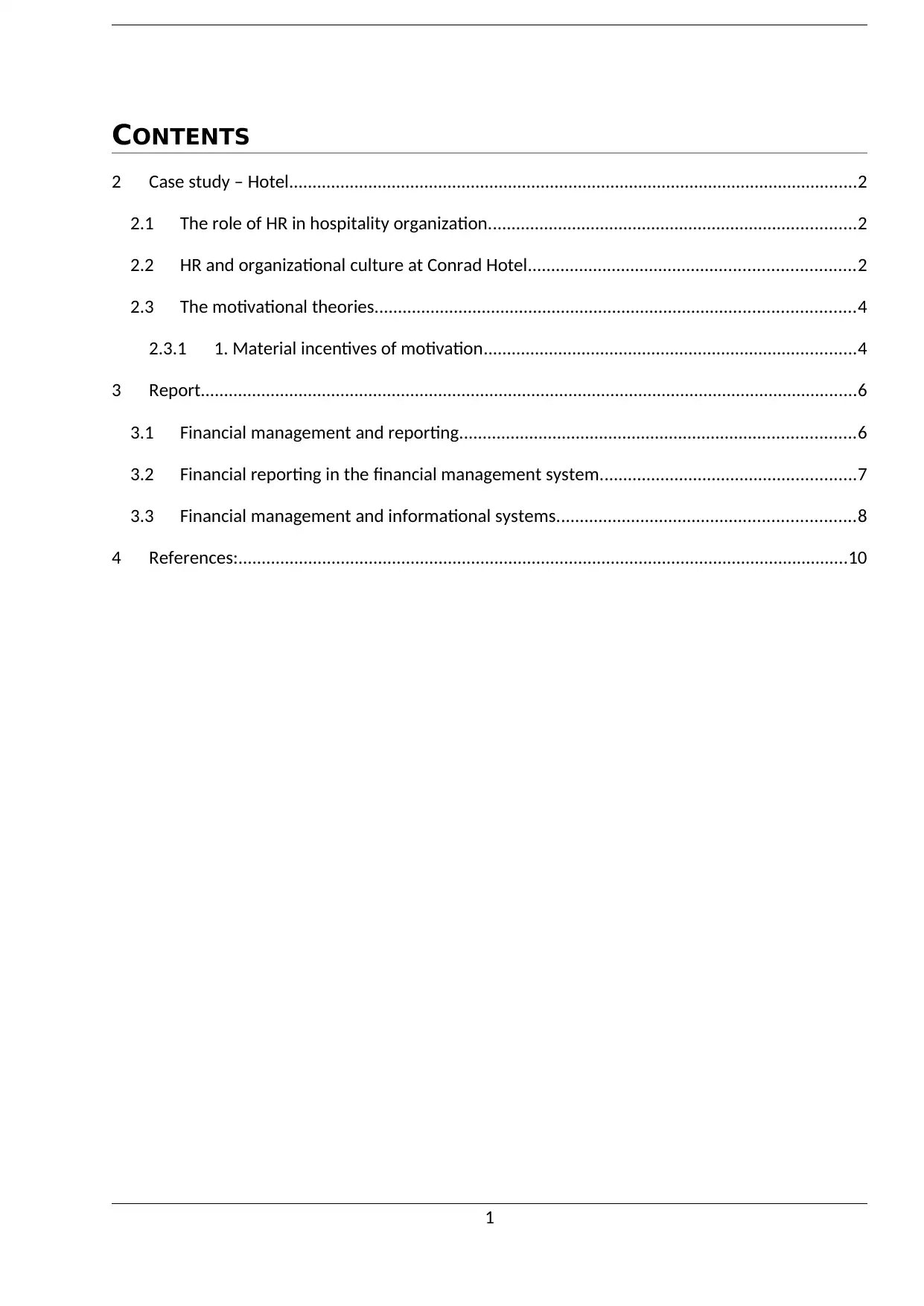
CONTENTS
2 Case study – Hotel..........................................................................................................................2
2.1 The role of HR in hospitality organization...............................................................................2
2.2 HR and organizational culture at Conrad Hotel......................................................................2
2.3 The motivational theories.......................................................................................................4
2.3.1 1. Material incentives of motivation................................................................................4
3 Report.............................................................................................................................................6
3.1 Financial management and reporting.....................................................................................6
3.2 Financial reporting in the financial management system.......................................................7
3.3 Financial management and informational systems................................................................8
4 References:...................................................................................................................................10
1
2 Case study – Hotel..........................................................................................................................2
2.1 The role of HR in hospitality organization...............................................................................2
2.2 HR and organizational culture at Conrad Hotel......................................................................2
2.3 The motivational theories.......................................................................................................4
2.3.1 1. Material incentives of motivation................................................................................4
3 Report.............................................................................................................................................6
3.1 Financial management and reporting.....................................................................................6
3.2 Financial reporting in the financial management system.......................................................7
3.3 Financial management and informational systems................................................................8
4 References:...................................................................................................................................10
1
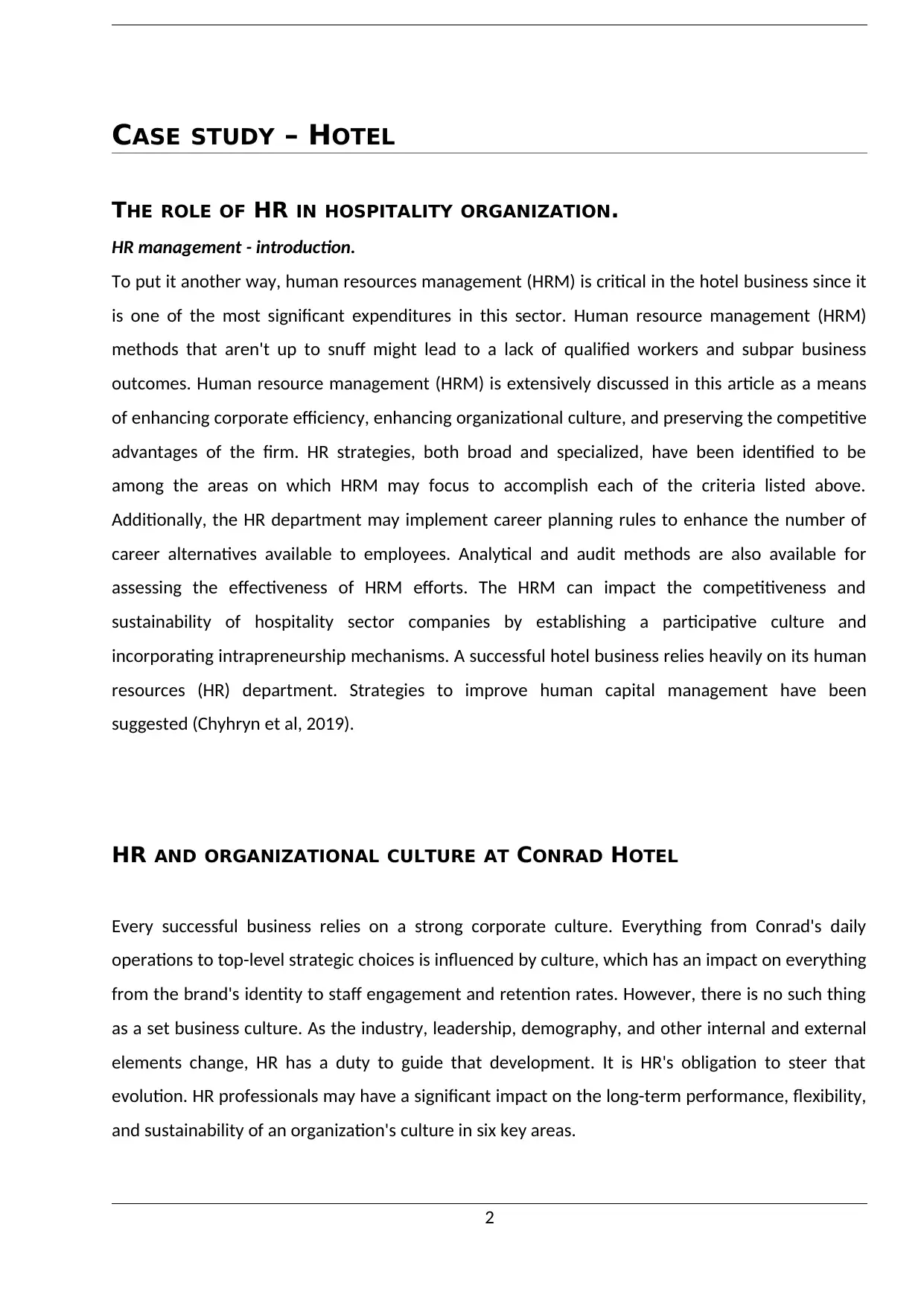
CASE STUDY – HOTEL
THE ROLE OF HR IN HOSPITALITY ORGANIZATION.
HR management - introduction.
To put it another way, human resources management (HRM) is critical in the hotel business since it
is one of the most significant expenditures in this sector. Human resource management (HRM)
methods that aren't up to snuff might lead to a lack of qualified workers and subpar business
outcomes. Human resource management (HRM) is extensively discussed in this article as a means
of enhancing corporate efficiency, enhancing organizational culture, and preserving the competitive
advantages of the firm. HR strategies, both broad and specialized, have been identified to be
among the areas on which HRM may focus to accomplish each of the criteria listed above.
Additionally, the HR department may implement career planning rules to enhance the number of
career alternatives available to employees. Analytical and audit methods are also available for
assessing the effectiveness of HRM efforts. The HRM can impact the competitiveness and
sustainability of hospitality sector companies by establishing a participative culture and
incorporating intrapreneurship mechanisms. A successful hotel business relies heavily on its human
resources (HR) department. Strategies to improve human capital management have been
suggested (Chyhryn et al, 2019).
HR AND ORGANIZATIONAL CULTURE AT CONRAD HOTEL
Every successful business relies on a strong corporate culture. Everything from Conrad's daily
operations to top-level strategic choices is influenced by culture, which has an impact on everything
from the brand's identity to staff engagement and retention rates. However, there is no such thing
as a set business culture. As the industry, leadership, demography, and other internal and external
elements change, HR has a duty to guide that development. It is HR's obligation to steer that
evolution. HR professionals may have a significant impact on the long-term performance, flexibility,
and sustainability of an organization's culture in six key areas.
2
THE ROLE OF HR IN HOSPITALITY ORGANIZATION.
HR management - introduction.
To put it another way, human resources management (HRM) is critical in the hotel business since it
is one of the most significant expenditures in this sector. Human resource management (HRM)
methods that aren't up to snuff might lead to a lack of qualified workers and subpar business
outcomes. Human resource management (HRM) is extensively discussed in this article as a means
of enhancing corporate efficiency, enhancing organizational culture, and preserving the competitive
advantages of the firm. HR strategies, both broad and specialized, have been identified to be
among the areas on which HRM may focus to accomplish each of the criteria listed above.
Additionally, the HR department may implement career planning rules to enhance the number of
career alternatives available to employees. Analytical and audit methods are also available for
assessing the effectiveness of HRM efforts. The HRM can impact the competitiveness and
sustainability of hospitality sector companies by establishing a participative culture and
incorporating intrapreneurship mechanisms. A successful hotel business relies heavily on its human
resources (HR) department. Strategies to improve human capital management have been
suggested (Chyhryn et al, 2019).
HR AND ORGANIZATIONAL CULTURE AT CONRAD HOTEL
Every successful business relies on a strong corporate culture. Everything from Conrad's daily
operations to top-level strategic choices is influenced by culture, which has an impact on everything
from the brand's identity to staff engagement and retention rates. However, there is no such thing
as a set business culture. As the industry, leadership, demography, and other internal and external
elements change, HR has a duty to guide that development. It is HR's obligation to steer that
evolution. HR professionals may have a significant impact on the long-term performance, flexibility,
and sustainability of an organization's culture in six key areas.
2
⊘ This is a preview!⊘
Do you want full access?
Subscribe today to unlock all pages.

Trusted by 1+ million students worldwide
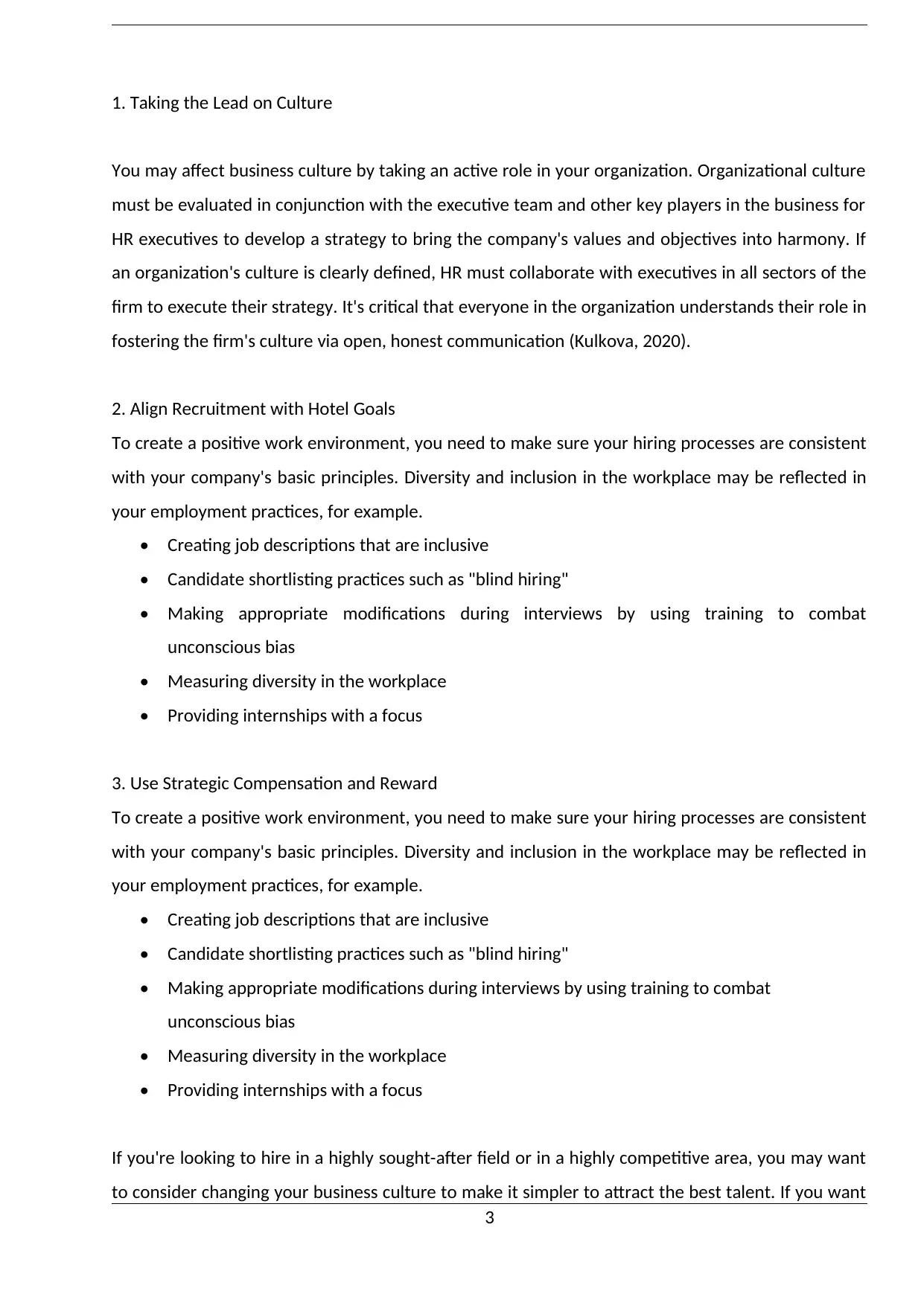
1. Taking the Lead on Culture
You may affect business culture by taking an active role in your organization. Organizational culture
must be evaluated in conjunction with the executive team and other key players in the business for
HR executives to develop a strategy to bring the company's values and objectives into harmony. If
an organization's culture is clearly defined, HR must collaborate with executives in all sectors of the
firm to execute their strategy. It's critical that everyone in the organization understands their role in
fostering the firm's culture via open, honest communication (Kulkova, 2020).
2. Align Recruitment with Hotel Goals
To create a positive work environment, you need to make sure your hiring processes are consistent
with your company's basic principles. Diversity and inclusion in the workplace may be reflected in
your employment practices, for example.
• Creating job descriptions that are inclusive
• Candidate shortlisting practices such as "blind hiring"
• Making appropriate modifications during interviews by using training to combat
unconscious bias
• Measuring diversity in the workplace
• Providing internships with a focus
3. Use Strategic Compensation and Reward
To create a positive work environment, you need to make sure your hiring processes are consistent
with your company's basic principles. Diversity and inclusion in the workplace may be reflected in
your employment practices, for example.
• Creating job descriptions that are inclusive
• Candidate shortlisting practices such as "blind hiring"
• Making appropriate modifications during interviews by using training to combat
unconscious bias
• Measuring diversity in the workplace
• Providing internships with a focus
If you're looking to hire in a highly sought-after field or in a highly competitive area, you may want
to consider changing your business culture to make it simpler to attract the best talent. If you want
3
You may affect business culture by taking an active role in your organization. Organizational culture
must be evaluated in conjunction with the executive team and other key players in the business for
HR executives to develop a strategy to bring the company's values and objectives into harmony. If
an organization's culture is clearly defined, HR must collaborate with executives in all sectors of the
firm to execute their strategy. It's critical that everyone in the organization understands their role in
fostering the firm's culture via open, honest communication (Kulkova, 2020).
2. Align Recruitment with Hotel Goals
To create a positive work environment, you need to make sure your hiring processes are consistent
with your company's basic principles. Diversity and inclusion in the workplace may be reflected in
your employment practices, for example.
• Creating job descriptions that are inclusive
• Candidate shortlisting practices such as "blind hiring"
• Making appropriate modifications during interviews by using training to combat
unconscious bias
• Measuring diversity in the workplace
• Providing internships with a focus
3. Use Strategic Compensation and Reward
To create a positive work environment, you need to make sure your hiring processes are consistent
with your company's basic principles. Diversity and inclusion in the workplace may be reflected in
your employment practices, for example.
• Creating job descriptions that are inclusive
• Candidate shortlisting practices such as "blind hiring"
• Making appropriate modifications during interviews by using training to combat
unconscious bias
• Measuring diversity in the workplace
• Providing internships with a focus
If you're looking to hire in a highly sought-after field or in a highly competitive area, you may want
to consider changing your business culture to make it simpler to attract the best talent. If you want
3
Paraphrase This Document
Need a fresh take? Get an instant paraphrase of this document with our AI Paraphraser
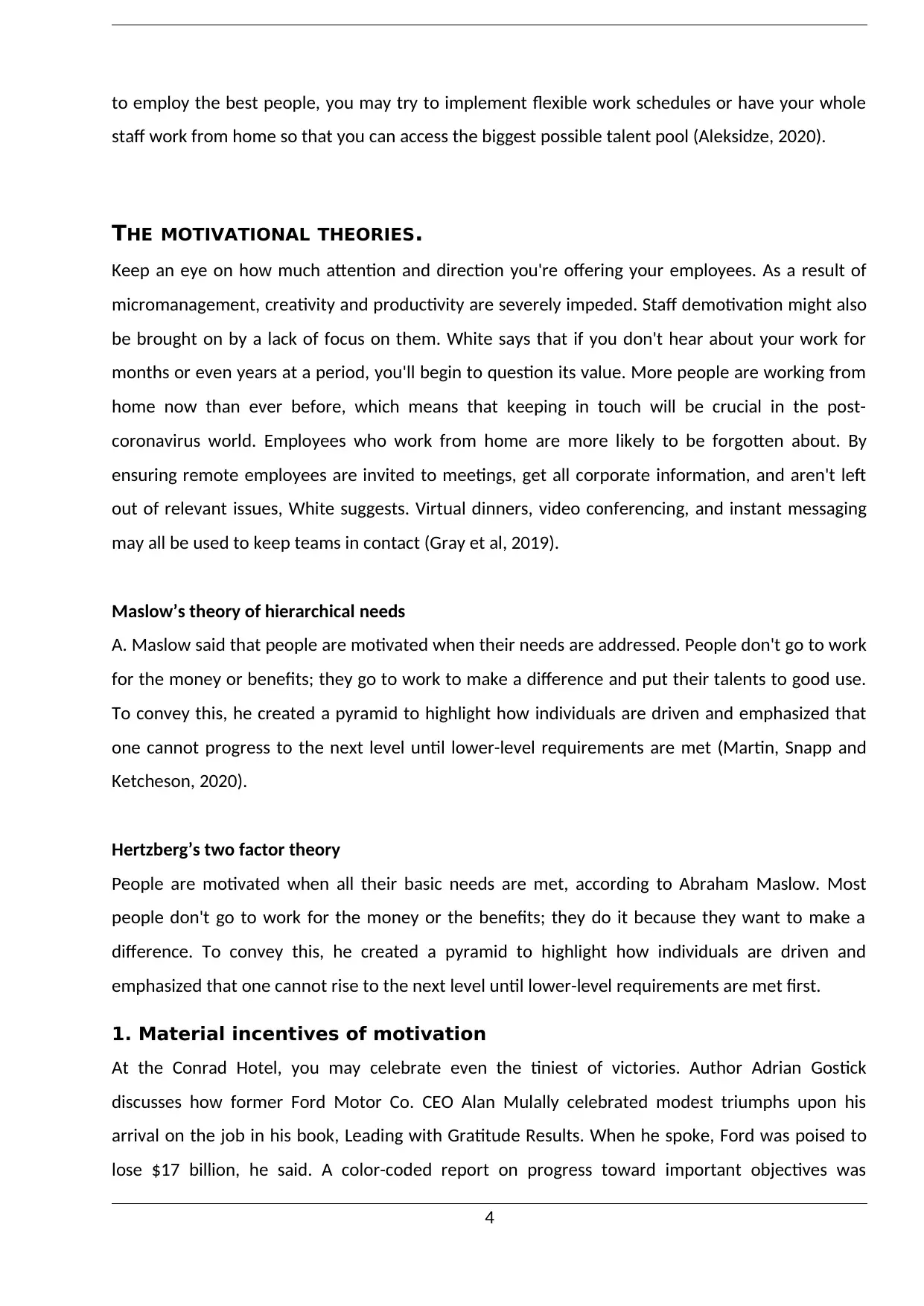
to employ the best people, you may try to implement flexible work schedules or have your whole
staff work from home so that you can access the biggest possible talent pool (Aleksidze, 2020).
THE MOTIVATIONAL THEORIES.
Keep an eye on how much attention and direction you're offering your employees. As a result of
micromanagement, creativity and productivity are severely impeded. Staff demotivation might also
be brought on by a lack of focus on them. White says that if you don't hear about your work for
months or even years at a period, you'll begin to question its value. More people are working from
home now than ever before, which means that keeping in touch will be crucial in the post-
coronavirus world. Employees who work from home are more likely to be forgotten about. By
ensuring remote employees are invited to meetings, get all corporate information, and aren't left
out of relevant issues, White suggests. Virtual dinners, video conferencing, and instant messaging
may all be used to keep teams in contact (Gray et al, 2019).
Maslow’s theory of hierarchical needs
A. Maslow said that people are motivated when their needs are addressed. People don't go to work
for the money or benefits; they go to work to make a difference and put their talents to good use.
To convey this, he created a pyramid to highlight how individuals are driven and emphasized that
one cannot progress to the next level until lower-level requirements are met (Martin, Snapp and
Ketcheson, 2020).
Hertzberg’s two factor theory
People are motivated when all their basic needs are met, according to Abraham Maslow. Most
people don't go to work for the money or the benefits; they do it because they want to make a
difference. To convey this, he created a pyramid to highlight how individuals are driven and
emphasized that one cannot rise to the next level until lower-level requirements are met first.
1. Material incentives of motivation
At the Conrad Hotel, you may celebrate even the tiniest of victories. Author Adrian Gostick
discusses how former Ford Motor Co. CEO Alan Mulally celebrated modest triumphs upon his
arrival on the job in his book, Leading with Gratitude Results. When he spoke, Ford was poised to
lose $17 billion, he said. A color-coded report on progress toward important objectives was
4
staff work from home so that you can access the biggest possible talent pool (Aleksidze, 2020).
THE MOTIVATIONAL THEORIES.
Keep an eye on how much attention and direction you're offering your employees. As a result of
micromanagement, creativity and productivity are severely impeded. Staff demotivation might also
be brought on by a lack of focus on them. White says that if you don't hear about your work for
months or even years at a period, you'll begin to question its value. More people are working from
home now than ever before, which means that keeping in touch will be crucial in the post-
coronavirus world. Employees who work from home are more likely to be forgotten about. By
ensuring remote employees are invited to meetings, get all corporate information, and aren't left
out of relevant issues, White suggests. Virtual dinners, video conferencing, and instant messaging
may all be used to keep teams in contact (Gray et al, 2019).
Maslow’s theory of hierarchical needs
A. Maslow said that people are motivated when their needs are addressed. People don't go to work
for the money or benefits; they go to work to make a difference and put their talents to good use.
To convey this, he created a pyramid to highlight how individuals are driven and emphasized that
one cannot progress to the next level until lower-level requirements are met (Martin, Snapp and
Ketcheson, 2020).
Hertzberg’s two factor theory
People are motivated when all their basic needs are met, according to Abraham Maslow. Most
people don't go to work for the money or the benefits; they do it because they want to make a
difference. To convey this, he created a pyramid to highlight how individuals are driven and
emphasized that one cannot rise to the next level until lower-level requirements are met first.
1. Material incentives of motivation
At the Conrad Hotel, you may celebrate even the tiniest of victories. Author Adrian Gostick
discusses how former Ford Motor Co. CEO Alan Mulally celebrated modest triumphs upon his
arrival on the job in his book, Leading with Gratitude Results. When he spoke, Ford was poised to
lose $17 billion, he said. A color-coded report on progress toward important objectives was
4
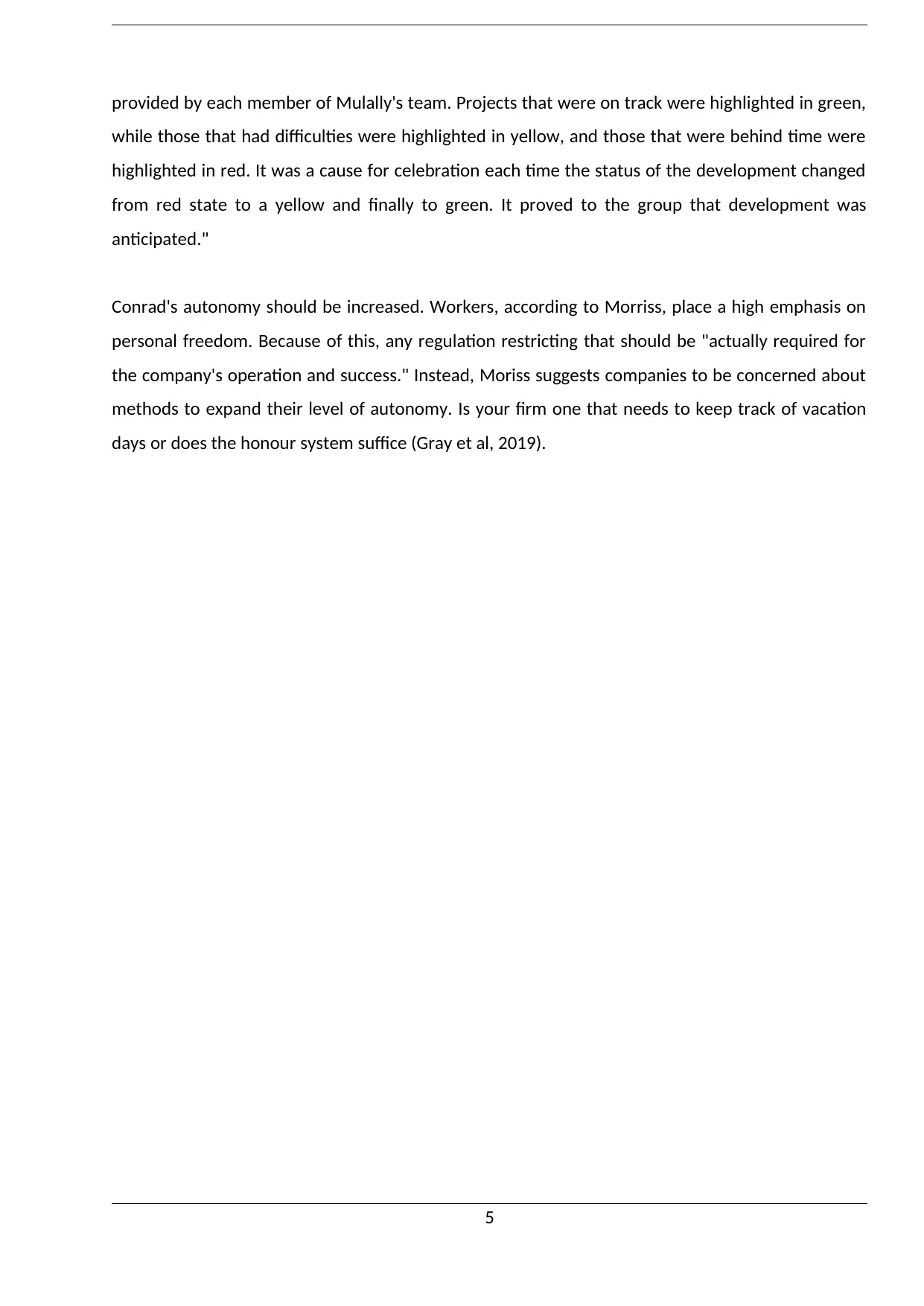
provided by each member of Mulally's team. Projects that were on track were highlighted in green,
while those that had difficulties were highlighted in yellow, and those that were behind time were
highlighted in red. It was a cause for celebration each time the status of the development changed
from red state to a yellow and finally to green. It proved to the group that development was
anticipated."
Conrad's autonomy should be increased. Workers, according to Morriss, place a high emphasis on
personal freedom. Because of this, any regulation restricting that should be "actually required for
the company's operation and success." Instead, Moriss suggests companies to be concerned about
methods to expand their level of autonomy. Is your firm one that needs to keep track of vacation
days or does the honour system suffice (Gray et al, 2019).
5
while those that had difficulties were highlighted in yellow, and those that were behind time were
highlighted in red. It was a cause for celebration each time the status of the development changed
from red state to a yellow and finally to green. It proved to the group that development was
anticipated."
Conrad's autonomy should be increased. Workers, according to Morriss, place a high emphasis on
personal freedom. Because of this, any regulation restricting that should be "actually required for
the company's operation and success." Instead, Moriss suggests companies to be concerned about
methods to expand their level of autonomy. Is your firm one that needs to keep track of vacation
days or does the honour system suffice (Gray et al, 2019).
5
⊘ This is a preview!⊘
Do you want full access?
Subscribe today to unlock all pages.

Trusted by 1+ million students worldwide
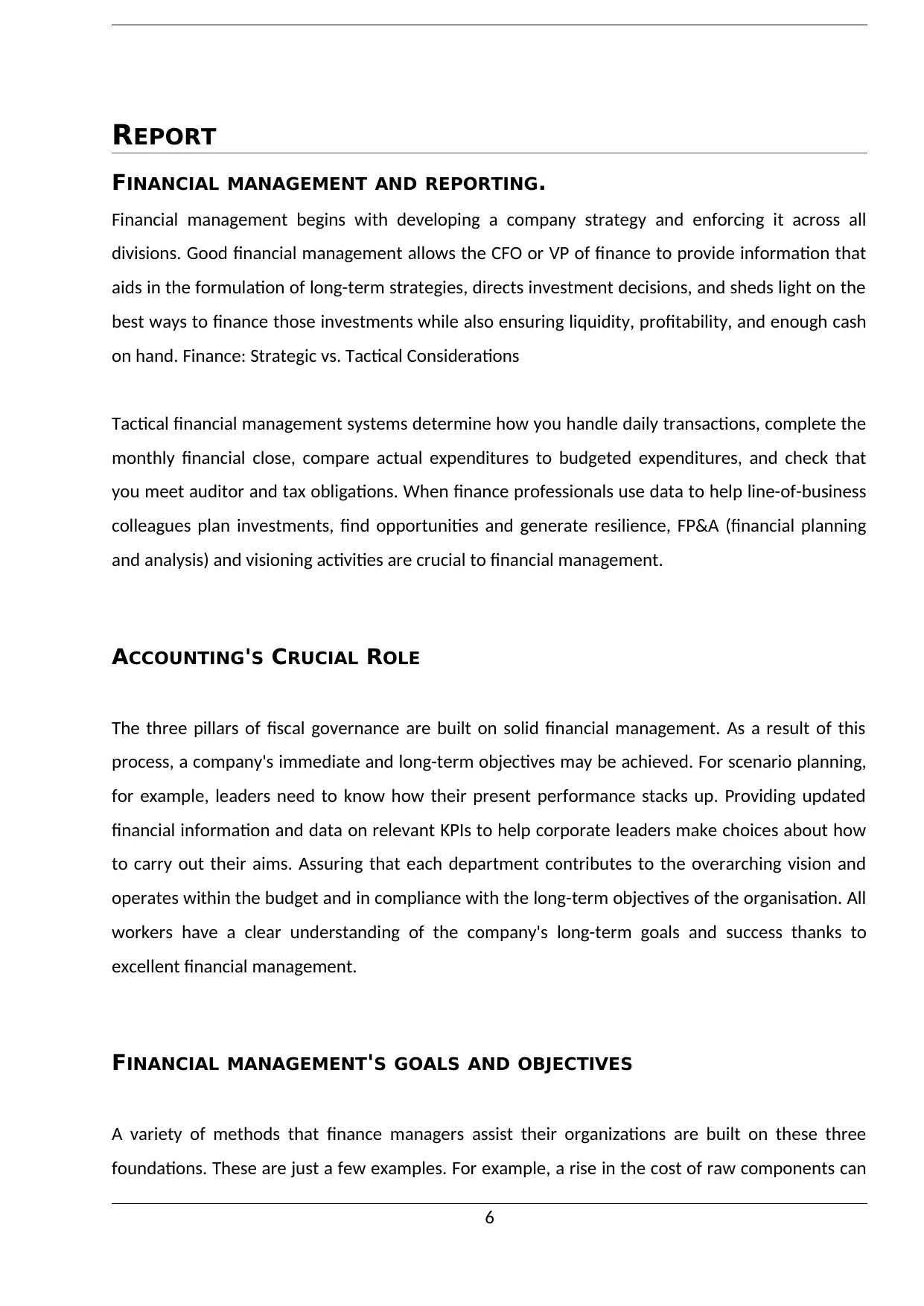
REPORT
FINANCIAL MANAGEMENT AND REPORTING.
Financial management begins with developing a company strategy and enforcing it across all
divisions. Good financial management allows the CFO or VP of finance to provide information that
aids in the formulation of long-term strategies, directs investment decisions, and sheds light on the
best ways to finance those investments while also ensuring liquidity, profitability, and enough cash
on hand. Finance: Strategic vs. Tactical Considerations
Tactical financial management systems determine how you handle daily transactions, complete the
monthly financial close, compare actual expenditures to budgeted expenditures, and check that
you meet auditor and tax obligations. When finance professionals use data to help line-of-business
colleagues plan investments, find opportunities and generate resilience, FP&A (financial planning
and analysis) and visioning activities are crucial to financial management.
ACCOUNTING'S CRUCIAL ROLE
The three pillars of fiscal governance are built on solid financial management. As a result of this
process, a company's immediate and long-term objectives may be achieved. For scenario planning,
for example, leaders need to know how their present performance stacks up. Providing updated
financial information and data on relevant KPIs to help corporate leaders make choices about how
to carry out their aims. Assuring that each department contributes to the overarching vision and
operates within the budget and in compliance with the long-term objectives of the organisation. All
workers have a clear understanding of the company's long-term goals and success thanks to
excellent financial management.
FINANCIAL MANAGEMENT'S GOALS AND OBJECTIVES
A variety of methods that finance managers assist their organizations are built on these three
foundations. These are just a few examples. For example, a rise in the cost of raw components can
6
FINANCIAL MANAGEMENT AND REPORTING.
Financial management begins with developing a company strategy and enforcing it across all
divisions. Good financial management allows the CFO or VP of finance to provide information that
aids in the formulation of long-term strategies, directs investment decisions, and sheds light on the
best ways to finance those investments while also ensuring liquidity, profitability, and enough cash
on hand. Finance: Strategic vs. Tactical Considerations
Tactical financial management systems determine how you handle daily transactions, complete the
monthly financial close, compare actual expenditures to budgeted expenditures, and check that
you meet auditor and tax obligations. When finance professionals use data to help line-of-business
colleagues plan investments, find opportunities and generate resilience, FP&A (financial planning
and analysis) and visioning activities are crucial to financial management.
ACCOUNTING'S CRUCIAL ROLE
The three pillars of fiscal governance are built on solid financial management. As a result of this
process, a company's immediate and long-term objectives may be achieved. For scenario planning,
for example, leaders need to know how their present performance stacks up. Providing updated
financial information and data on relevant KPIs to help corporate leaders make choices about how
to carry out their aims. Assuring that each department contributes to the overarching vision and
operates within the budget and in compliance with the long-term objectives of the organisation. All
workers have a clear understanding of the company's long-term goals and success thanks to
excellent financial management.
FINANCIAL MANAGEMENT'S GOALS AND OBJECTIVES
A variety of methods that finance managers assist their organizations are built on these three
foundations. These are just a few examples. For example, a rise in the cost of raw components can
6
Paraphrase This Document
Need a fresh take? Get an instant paraphrase of this document with our AI Paraphraser
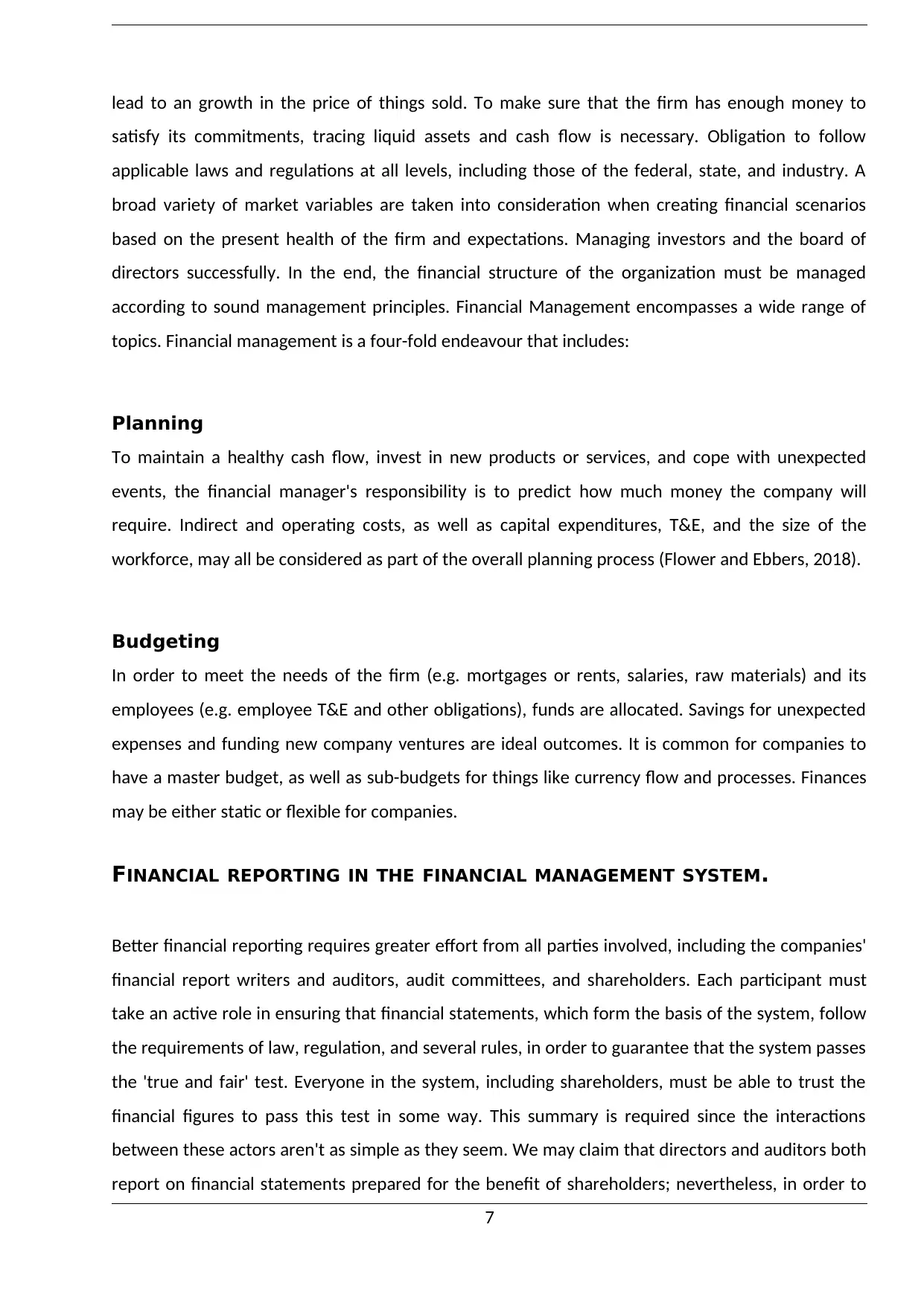
lead to an growth in the price of things sold. To make sure that the firm has enough money to
satisfy its commitments, tracing liquid assets and cash flow is necessary. Obligation to follow
applicable laws and regulations at all levels, including those of the federal, state, and industry. A
broad variety of market variables are taken into consideration when creating financial scenarios
based on the present health of the firm and expectations. Managing investors and the board of
directors successfully. In the end, the financial structure of the organization must be managed
according to sound management principles. Financial Management encompasses a wide range of
topics. Financial management is a four-fold endeavour that includes:
Planning
To maintain a healthy cash flow, invest in new products or services, and cope with unexpected
events, the financial manager's responsibility is to predict how much money the company will
require. Indirect and operating costs, as well as capital expenditures, T&E, and the size of the
workforce, may all be considered as part of the overall planning process (Flower and Ebbers, 2018).
Budgeting
In order to meet the needs of the firm (e.g. mortgages or rents, salaries, raw materials) and its
employees (e.g. employee T&E and other obligations), funds are allocated. Savings for unexpected
expenses and funding new company ventures are ideal outcomes. It is common for companies to
have a master budget, as well as sub-budgets for things like currency flow and processes. Finances
may be either static or flexible for companies.
FINANCIAL REPORTING IN THE FINANCIAL MANAGEMENT SYSTEM.
Better financial reporting requires greater effort from all parties involved, including the companies'
financial report writers and auditors, audit committees, and shareholders. Each participant must
take an active role in ensuring that financial statements, which form the basis of the system, follow
the requirements of law, regulation, and several rules, in order to guarantee that the system passes
the 'true and fair' test. Everyone in the system, including shareholders, must be able to trust the
financial figures to pass this test in some way. This summary is required since the interactions
between these actors aren't as simple as they seem. We may claim that directors and auditors both
report on financial statements prepared for the benefit of shareholders; nevertheless, in order to
7
satisfy its commitments, tracing liquid assets and cash flow is necessary. Obligation to follow
applicable laws and regulations at all levels, including those of the federal, state, and industry. A
broad variety of market variables are taken into consideration when creating financial scenarios
based on the present health of the firm and expectations. Managing investors and the board of
directors successfully. In the end, the financial structure of the organization must be managed
according to sound management principles. Financial Management encompasses a wide range of
topics. Financial management is a four-fold endeavour that includes:
Planning
To maintain a healthy cash flow, invest in new products or services, and cope with unexpected
events, the financial manager's responsibility is to predict how much money the company will
require. Indirect and operating costs, as well as capital expenditures, T&E, and the size of the
workforce, may all be considered as part of the overall planning process (Flower and Ebbers, 2018).
Budgeting
In order to meet the needs of the firm (e.g. mortgages or rents, salaries, raw materials) and its
employees (e.g. employee T&E and other obligations), funds are allocated. Savings for unexpected
expenses and funding new company ventures are ideal outcomes. It is common for companies to
have a master budget, as well as sub-budgets for things like currency flow and processes. Finances
may be either static or flexible for companies.
FINANCIAL REPORTING IN THE FINANCIAL MANAGEMENT SYSTEM.
Better financial reporting requires greater effort from all parties involved, including the companies'
financial report writers and auditors, audit committees, and shareholders. Each participant must
take an active role in ensuring that financial statements, which form the basis of the system, follow
the requirements of law, regulation, and several rules, in order to guarantee that the system passes
the 'true and fair' test. Everyone in the system, including shareholders, must be able to trust the
financial figures to pass this test in some way. This summary is required since the interactions
between these actors aren't as simple as they seem. We may claim that directors and auditors both
report on financial statements prepared for the benefit of shareholders; nevertheless, in order to
7
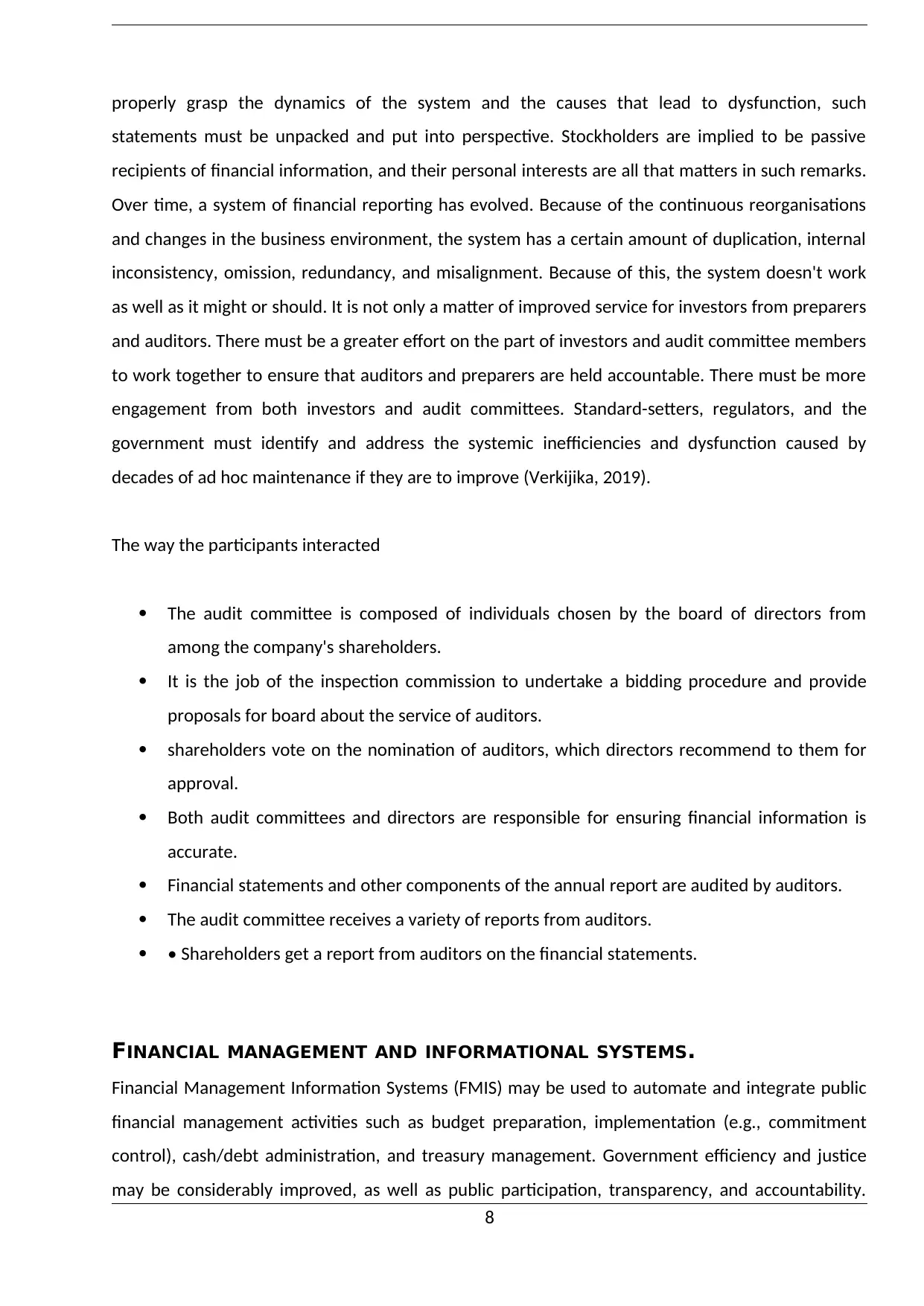
properly grasp the dynamics of the system and the causes that lead to dysfunction, such
statements must be unpacked and put into perspective. Stockholders are implied to be passive
recipients of financial information, and their personal interests are all that matters in such remarks.
Over time, a system of financial reporting has evolved. Because of the continuous reorganisations
and changes in the business environment, the system has a certain amount of duplication, internal
inconsistency, omission, redundancy, and misalignment. Because of this, the system doesn't work
as well as it might or should. It is not only a matter of improved service for investors from preparers
and auditors. There must be a greater effort on the part of investors and audit committee members
to work together to ensure that auditors and preparers are held accountable. There must be more
engagement from both investors and audit committees. Standard-setters, regulators, and the
government must identify and address the systemic inefficiencies and dysfunction caused by
decades of ad hoc maintenance if they are to improve (Verkijika, 2019).
The way the participants interacted
The audit committee is composed of individuals chosen by the board of directors from
among the company's shareholders.
It is the job of the inspection commission to undertake a bidding procedure and provide
proposals for board about the service of auditors.
shareholders vote on the nomination of auditors, which directors recommend to them for
approval.
Both audit committees and directors are responsible for ensuring financial information is
accurate.
Financial statements and other components of the annual report are audited by auditors.
The audit committee receives a variety of reports from auditors.
• Shareholders get a report from auditors on the financial statements.
FINANCIAL MANAGEMENT AND INFORMATIONAL SYSTEMS.
Financial Management Information Systems (FMIS) may be used to automate and integrate public
financial management activities such as budget preparation, implementation (e.g., commitment
control), cash/debt administration, and treasury management. Government efficiency and justice
may be considerably improved, as well as public participation, transparency, and accountability.
8
statements must be unpacked and put into perspective. Stockholders are implied to be passive
recipients of financial information, and their personal interests are all that matters in such remarks.
Over time, a system of financial reporting has evolved. Because of the continuous reorganisations
and changes in the business environment, the system has a certain amount of duplication, internal
inconsistency, omission, redundancy, and misalignment. Because of this, the system doesn't work
as well as it might or should. It is not only a matter of improved service for investors from preparers
and auditors. There must be a greater effort on the part of investors and audit committee members
to work together to ensure that auditors and preparers are held accountable. There must be more
engagement from both investors and audit committees. Standard-setters, regulators, and the
government must identify and address the systemic inefficiencies and dysfunction caused by
decades of ad hoc maintenance if they are to improve (Verkijika, 2019).
The way the participants interacted
The audit committee is composed of individuals chosen by the board of directors from
among the company's shareholders.
It is the job of the inspection commission to undertake a bidding procedure and provide
proposals for board about the service of auditors.
shareholders vote on the nomination of auditors, which directors recommend to them for
approval.
Both audit committees and directors are responsible for ensuring financial information is
accurate.
Financial statements and other components of the annual report are audited by auditors.
The audit committee receives a variety of reports from auditors.
• Shareholders get a report from auditors on the financial statements.
FINANCIAL MANAGEMENT AND INFORMATIONAL SYSTEMS.
Financial Management Information Systems (FMIS) may be used to automate and integrate public
financial management activities such as budget preparation, implementation (e.g., commitment
control), cash/debt administration, and treasury management. Government efficiency and justice
may be considerably improved, as well as public participation, transparency, and accountability.
8
⊘ This is a preview!⊘
Do you want full access?
Subscribe today to unlock all pages.

Trusted by 1+ million students worldwide
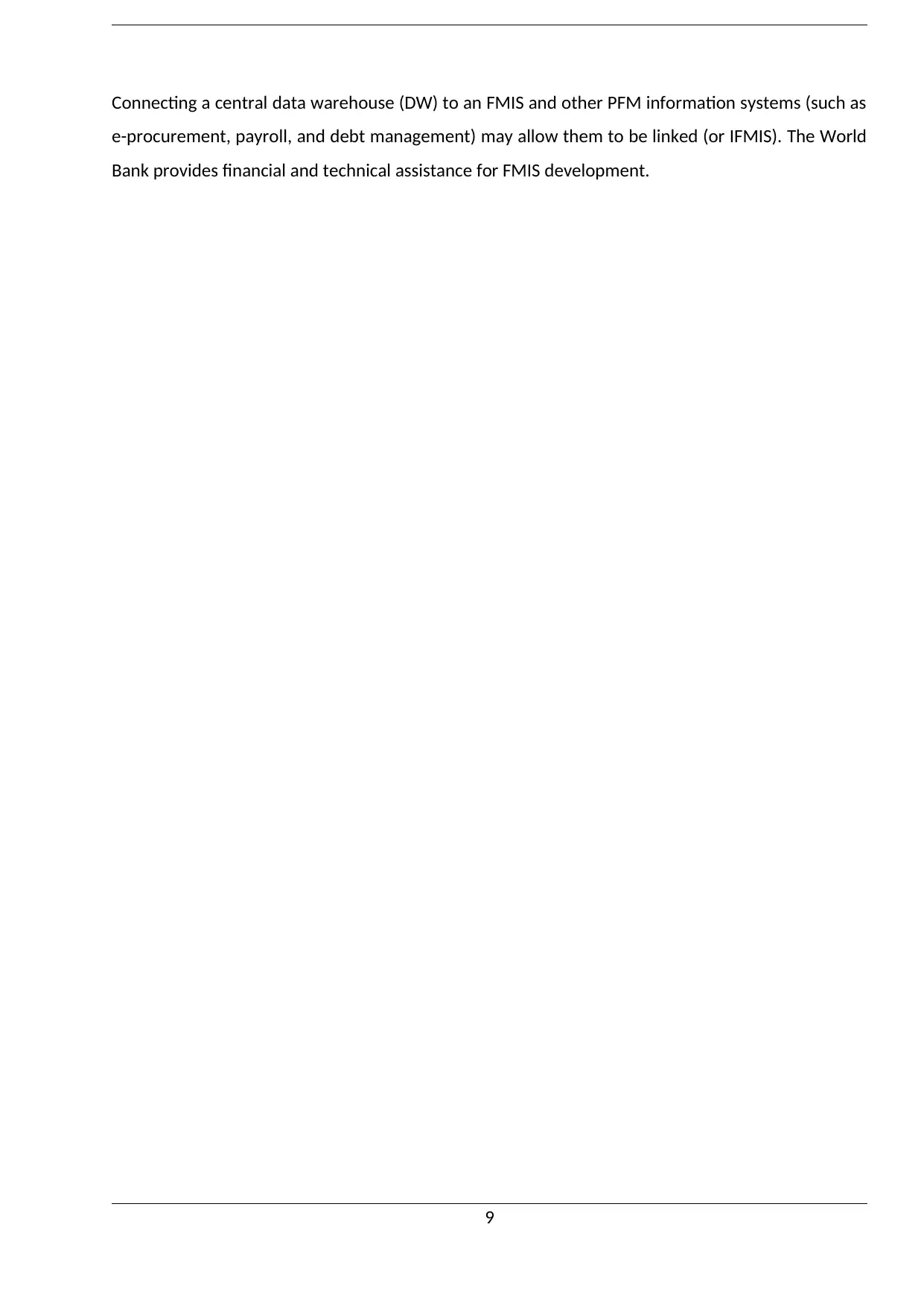
Connecting a central data warehouse (DW) to an FMIS and other PFM information systems (such as
e-procurement, payroll, and debt management) may allow them to be linked (or IFMIS). The World
Bank provides financial and technical assistance for FMIS development.
9
e-procurement, payroll, and debt management) may allow them to be linked (or IFMIS). The World
Bank provides financial and technical assistance for FMIS development.
9
Paraphrase This Document
Need a fresh take? Get an instant paraphrase of this document with our AI Paraphraser
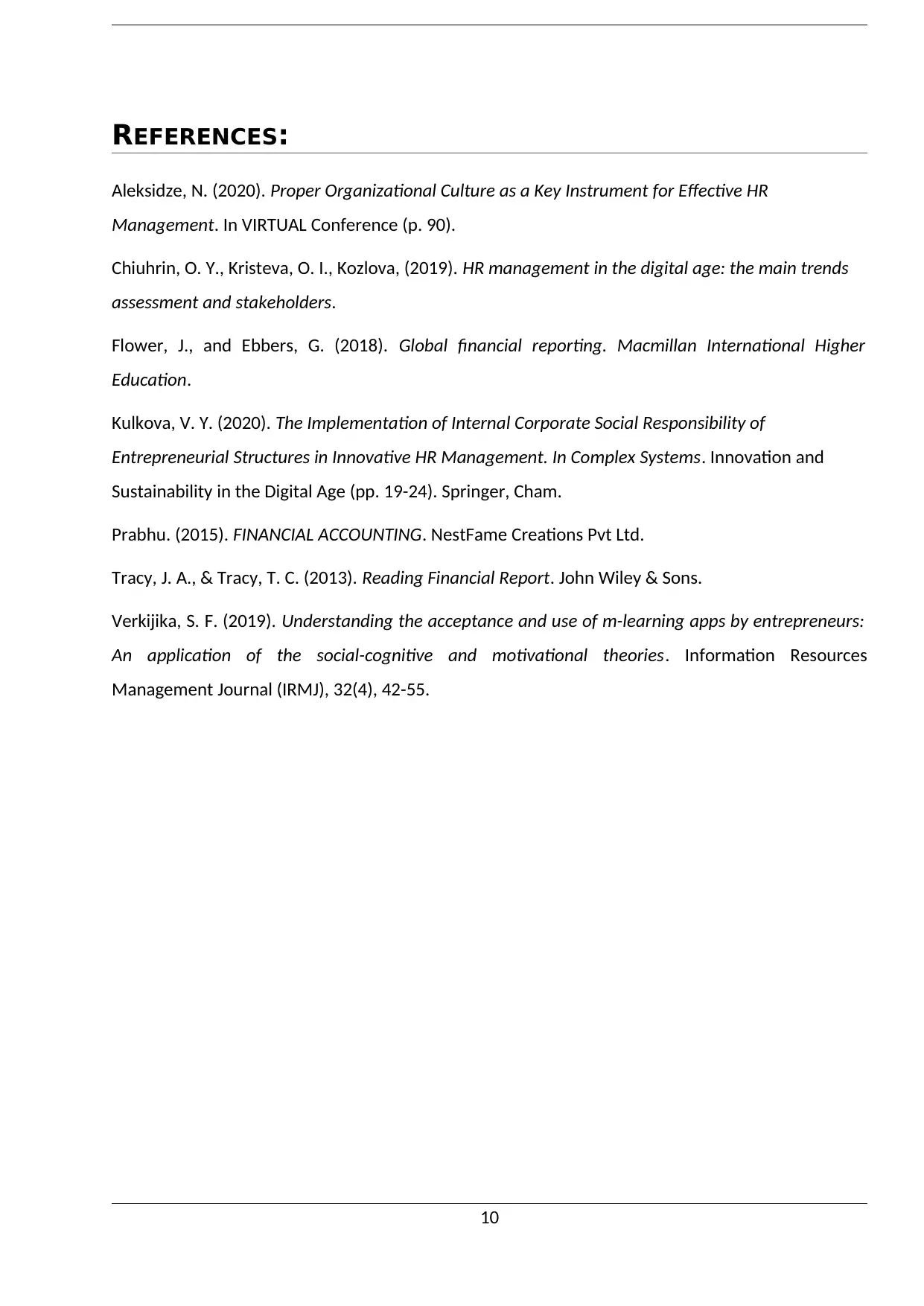
REFERENCES:
Aleksidze, N. (2020). Proper Organizational Culture as a Key Instrument for Effective HR
Management. In VIRTUAL Conference (p. 90).
Chiuhrin, O. Y., Kristeva, O. I., Kozlova, (2019). HR management in the digital age: the main trends
assessment and stakeholders.
Flower, J., and Ebbers, G. (2018). Global financial reporting. Macmillan International Higher
Education.
Kulkova, V. Y. (2020). The Implementation of Internal Corporate Social Responsibility of
Entrepreneurial Structures in Innovative HR Management. In Complex Systems. Innovation and
Sustainability in the Digital Age (pp. 19-24). Springer, Cham.
Prabhu. (2015). FINANCIAL ACCOUNTING. NestFame Creations Pvt Ltd.
Tracy, J. A., & Tracy, T. C. (2013). Reading Financial Report. John Wiley & Sons.
Verkijika, S. F. (2019). Understanding the acceptance and use of m-learning apps by entrepreneurs:
An application of the social-cognitive and motivational theories. Information Resources
Management Journal (IRMJ), 32(4), 42-55.
10
Aleksidze, N. (2020). Proper Organizational Culture as a Key Instrument for Effective HR
Management. In VIRTUAL Conference (p. 90).
Chiuhrin, O. Y., Kristeva, O. I., Kozlova, (2019). HR management in the digital age: the main trends
assessment and stakeholders.
Flower, J., and Ebbers, G. (2018). Global financial reporting. Macmillan International Higher
Education.
Kulkova, V. Y. (2020). The Implementation of Internal Corporate Social Responsibility of
Entrepreneurial Structures in Innovative HR Management. In Complex Systems. Innovation and
Sustainability in the Digital Age (pp. 19-24). Springer, Cham.
Prabhu. (2015). FINANCIAL ACCOUNTING. NestFame Creations Pvt Ltd.
Tracy, J. A., & Tracy, T. C. (2013). Reading Financial Report. John Wiley & Sons.
Verkijika, S. F. (2019). Understanding the acceptance and use of m-learning apps by entrepreneurs:
An application of the social-cognitive and motivational theories. Information Resources
Management Journal (IRMJ), 32(4), 42-55.
10
1 out of 11
Related Documents
Your All-in-One AI-Powered Toolkit for Academic Success.
+13062052269
info@desklib.com
Available 24*7 on WhatsApp / Email
![[object Object]](/_next/static/media/star-bottom.7253800d.svg)
Unlock your academic potential
Copyright © 2020–2025 A2Z Services. All Rights Reserved. Developed and managed by ZUCOL.





